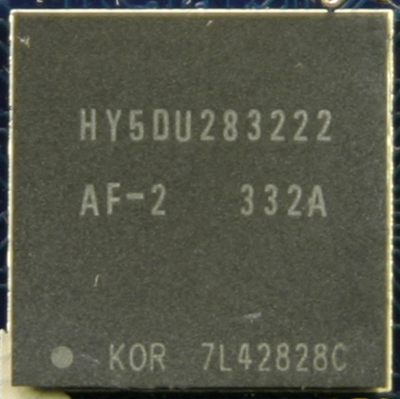Memory Modules
Before DX9 cards came along, memory speed and bandwidth were all important. There were plenty of instances in which GPUs were starved for action because they weren't able to get data fast enough. Now, though, raw computing power is presenting itself as the main driving force behind high quality graphics. The reason for this is that some cool effects, which used to be done with a memory trick, can now be done programmatically with pixel and vertex shaders. This doesn't mean that having fast memory is unimportant (we still need to move a high volume of data), and we are going to try to get as much data flowing as possible for this review.The two memory makers that we are going to see coming to the plate in this roundup are Samsung and Hynix. On both ATI's and NVIDIA's top end cards, we are seeing Hynix GDDR-II modules on board, while the mid-range products are outfitted with the Samsung parts.

Hynix 2ns Ram Module
The high-end Hynix HY5DU283222 and Hynix HY5DU573222 are used on NVIDIA 59xx and Radeon 98xx cards, respectively. NVIDIA requires 2ns RAM for its 5950 cards to hit a 950 MHz data rate, while ATI only needs the 2.5ns modules, as it doesn't need more than an 800MHz data rate. The NVIDIA GeForce FX 5900 that we tested sports 2.8ns Hynix RAM rather than the 2ns of the 5950s.

Samsung 2.8ns Ram Module
RAM for the Radeon 9600XT tops out at 700MHz effective rate speeds, which is more than enough room to hit the reference specification of a 600MHz data rate. The Samsung RAM that NVIDIA employs is a bit faster at 2.2ns, and we have seen some cases where this RAM ran stable beyond the 900MHz data rate, which should have been its limit.
The modules themselves have a great deal to do with how fast the memory on a graphics card can be run, but beyond the simple specs of the memory itself, performance is affected greatly by board layout, latency settings, and cooling. All of these aspects are controlled by the OEM, and all of them have a large impact on how well memory on a card will overclock.
The first thing that we had hoped for when we saw that Crucial had entered the graphics card market was that they would equip their cards with their own RAM. Unfortunately, that's not the case, as all the cards that we've seen from them follow suit with the other cards in their category.
Since we aren't seeing any variation on what RAM OEMs are pairing GPUs, the variances in RAM speed among similar cards will be due to the aspects that we mentioned before, as well as a little luck of the draw (overclocking isn't an exact science, and every single part is unique even if its from the same batch of chips).










44 Comments
View All Comments
Icewind - Wednesday, February 4, 2004 - link
Were are the comparison charts between the overclocked and stock speed 9800pro's? I must be blind, because I can't see them.par - Wednesday, February 4, 2004 - link
Where can I find the passively cooled 9600XT by sapphire? Newegg shows sapphires 9600xt with a fan.DerekWilson - Wednesday, February 4, 2004 - link
The Seagate HD: Barracuda 7200.7 PATA ... I'll add that to the tablemostlyprudent - Wednesday, February 4, 2004 - link
Nice article. A passively cooled 9600XT?!...I've found my next video card. There is one thing that I am unclear about - the Seagate hard drive used in the test setup - is it an SATA drive?